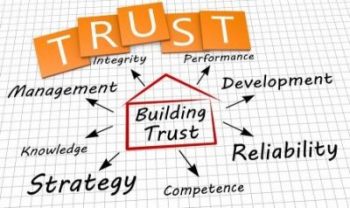Why do nine out of 10 leaders rate so poorly on measures of trust? Whether or not your leaders are trustworthy or not, it doesn’t take much to create an atmosphere of distrust. The solutions aren’t as complicated as one might think.
To improve your connection to people and build a culture of trust, try these techniques:
- Go on a walkabout: Walk around the office each day to touch base with individual contributors to your company’s success. While email and group meetings are important, one-on-one “face time” is critical.
- Capture vital statistics: Learn about each employee’s life: spouse’s name, children’s names and ages, major hobbies. Use questions to elicit meaningful information: “Where are you from?” or “What do you do on your days off?”
- Find similarities: Instead of focusing on differences, find mutual interests (hobbies, desires, career goals).
- Ask for ideas and feedback: Trust must already be established for people to be honest with you. Ask what they need to perform their jobs better. Acknowledge that you hear their opinions and will think about what they’ve said. Don’t dismiss or argue the merits of their input; offer a simple and genuine “thanks for sharing that.”
- Acknowledge progress and milestones: In many organizations, problems are solved, barriers are surmounted, tasks are completed… and nothing is noted. People crave acknowledgment and recognition, so seize these opportunities to build trust. Celebrate progress. Don’t let it slip by unnoticed.
When Trust Is Broken
It takes years to build up trust and only seconds to destroy it. ~ Anonymous
Trust is a key factor we discuss in my coaching engagements with clients. There’s nothing that poisons a relationship as much as mistrust. Confront the issues as soon as possible.
When trust is broken, take immediate steps to fix the problem instead of ignoring or downplaying it. Employees will be skeptical and/or suspicious, so choose your words carefully. Acknowledge that trust has been damaged, and start the recovery process as quickly as possible.
You needn’t have all the answers or a detailed plan. There can even be a lag between naming the problem and describing what you’ll do. Just let people know that you’re aware of the issue and its impact on them, and that you’re committed to setting things right.
Identify the problem as precisely as possible. Is there an adversarial relationship between people in the sales offices and those at headquarters? Are people doing end runs around a department that has a reputation for arrogance?
Imagine what success will look like in practice. You may, for example, establish clear roles and responsibilities, an exceptions policy, a dispute resolution process, and submission and response protocols. In meetings, you can spend less time assigning blame and more time on what the staff is doing right.
With greater trust, managers and leaders can reap tangible business benefits: increased productivity, improved performance and genuine employee engagement.
I know it can be hard to deal with a lack of trust. But nothing is more important. What’s been your experience with lack of leadership trust? I’d love to hear from you. You can call me at 561-582-6060, let’s talk. And as always, I can be reached here or on LinkedIn.

Did You Enjoy This Article?
Join thousands of other smart business owners like yourself & get our Proffittable Times newsletter.
It's filled with actionable content you can apply immediately.
Sign up now to get started!
– Coach Nancy










